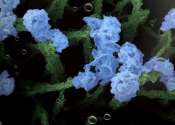New nanostructure for batteries keeps going and going
(Phys.org) -- For more than a decade, scientists have tried to improve lithium-based batteries by replacing the graphite in one terminal with silicon, which can store 10 times more charge. But after just a few charge/discharge ...









